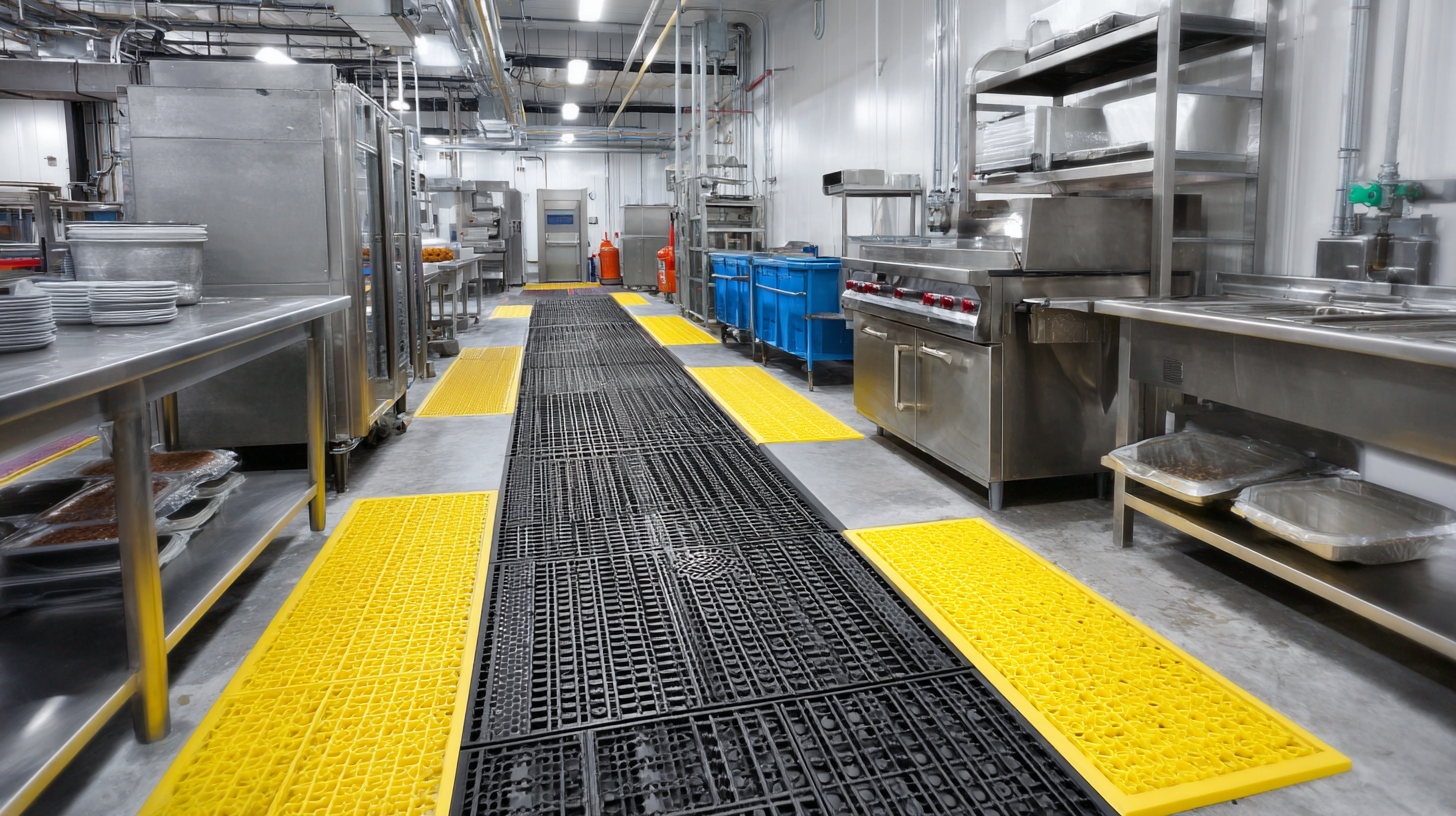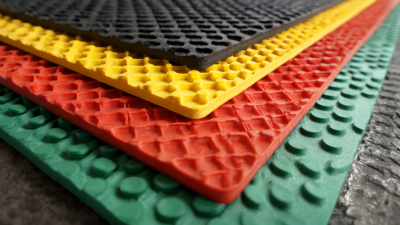Enhancing Workplace Safety: The Science Behind Industrial Floor Mats and Their Benefits
In today's industrial environment, workplace safety is more critical than ever, with the National Safety Council reporting that a worker is injured every seven seconds in the United States. A significant contributor to these injuries is the condition of the floor, which can lead to slips, trips, and falls—accounting for over 30% of non-fatal workplace injuries. To mitigate these risks, many organizations are turning to industrial floor mats, which have been proven to enhance safety by providing improved traction and cushioning for workers.
Recent studies indicate that implementing industrial floor mats can reduce slip and fall accidents by up to 50%, showcasing their effectiveness in creating a safer work environment. These mats are designed not only to prevent accidents but also to promote employee comfort and productivity, an essential consideration in industries where workers spend long hours on their feet. By investing in high-quality industrial floor mats, businesses can foster a culture of safety, ultimately protecting their employees and reducing potential liabilities associated with workplace injuries.

The Role of Industrial Floor Mats in Reducing Workplace Injuries and Accidents
Industrial floor mats play a crucial role in enhancing workplace safety by significantly reducing the risk of accidents and injuries. According to a recent study by the Bureau of Labor Statistics, slips, trips, and falls account for nearly 30% of all workplace injuries, underscoring the importance of preventive measures. By incorporating high-quality industrial floor mats, businesses can create a safer environment that minimizes these hazards. These mats are designed with slip-resistant surfaces and shock-absorbing materials, which not only improve traction but also provide cushioning for employees who are standing for prolonged periods.
Furthermore, the use of industrial floor mats can lead to reduced healthcare costs associated with workplace injuries. A report from the National Safety Council reveals that the average cost of a workplace injury is over $40,000 when factoring in medical expenses, lost wages, and other related costs. By investing in durable and effective floor mats, employers can potentially save significant amounts in workers' compensation claims and increase overall productivity. In addition, mats designed for specific industries can help with spill containment and maintain cleanliness, further contributing to a safer work environment and demonstrating a proactive approach to workplace safety management.
Key Statistics: The Financial Impact of Workplace Injuries on Businesses
Workplace injuries can lead to substantial financial burdens for businesses, with statistics revealing a staggering cost associated with these incidents. According to research, businesses in the United States pay approximately $1 billion per week in direct costs related to workplace injuries. These expenses encompass medical treatments, legal fees, and worker's compensation claims. Beyond direct costs, indirect expenses, such as lost productivity and training replacement employees, can multiply these figures, compounding the financial impact on organizations.

The science behind industrial floor mats reveals how these simple yet effective tools can mitigate risks and reduce injury-related costs. By providing traction, cushioning, and ergonomic support, floor mats can significantly lower the likelihood of slips, trips, and falls—the leading causes of workplace injuries. Organizations investing in high-quality industrial mats not only enhance the safety of their work environment but also protect their bottom line, as reducing injuries translates directly to better financial health and improved operational efficiency.
Materials Matter: The Science Behind Anti-Fatigue and Slip-Resistant Mats
When it comes to workplace safety, selecting the right materials for flooring is paramount. Anti-fatigue and slip-resistant mats play a crucial role in enhancing comfort and reducing accidents in industrial environments. These specialized mats are designed to alleviate stress on workers' legs and feet during prolonged standing while preventing slips and falls. By incorporating elements such as cushioning and textured surfaces, they provide essential support and grip, making them indispensable in busy workplaces.
Tips: When choosing mats for your workplace, look for those with a high coefficient of friction to ensure maximum slip resistance. Additionally, opt for materials that can withstand industrial cleaning and heavy foot traffic, such as rubber or vinyl. Regularly inspect the mats for wear and tear, as maintaining their integrity is vital for ongoing safety.
Another important aspect is the thickness and density of the mats. Thicker mats with greater density offer better shock absorption and comfort, reducing fatigue significantly. Consider the specific needs of your environment and the nature of the tasks being performed. This way, the chosen mats will not only enhance safety but also contribute to a more productive and healthier workforce.
Tips: To maximize the effectiveness of your mats, position them in high-traffic areas where slips are more likely to occur, such as near entrances, workstations, and around machinery. Regular cleaning can also enhance their longevity and performance, ensuring a safe and productive workspace.
Comparative Analysis: Standard Flooring vs. Industrial Mats in Safety Performance
When comparing standard flooring to industrial mats in terms of safety performance, the differences are striking. Standard flooring, while commonly used in various workplaces, often lacks the cushioning and slip-resistant properties required in high-risk environments. This can lead to increased rates of slips, trips, and falls, resulting in workplace injuries and lost productivity. Standard surfaces may be hard and unforgiving, which not only affects comfort but can also contribute to fatigue over long periods of standing or walking.
On the other hand, industrial floor mats are specifically designed to enhance safety through advanced materials and designs. These mats typically feature textured surfaces that provide superior traction, reducing the likelihood of slips, especially in wet or oily conditions. Furthermore, they are often made from materials that offer shock absorption, making them ideal for environments where workers are on their feet for extended periods. By prioritizing safety, these mats not only improve employee well-being but also help organizations minimize costs associated with workplace injuries, thereby creating a more productive and secure work environment.

Best Practices for Implementing Floor Mats in High-Risk Work Environments
In high-risk work environments, implementing effective safety measures is crucial for reducing workplace injuries. One of the best practices is the use of industrial floor mats, which provide multiple benefits for enhancing workplace safety. These mats not only improve traction and reduce slip risks but also offer cushioning that can minimize the impact from falls or long hours of standing. Properly placed mats can significantly lower the incidence of slip-and-fall accidents, which are among the most common workplace injuries.
When integrating industrial floor mats into your workplace, consider the following tips: First, assess high-traffic areas and places prone to spills to ensure mats are strategically placed where they are most needed. Second, select mats that are designed for your specific environment, such as anti-fatigue mats for employees standing long hours or mats with drainage systems for wet areas. Finally, regular maintenance is essential; keep mats clean and in good condition to preserve their effectiveness and safety. By adopting these best practices, organizations can foster a safer working environment while enhancing overall productivity.
Related Posts
-

2025 Market Insights: The Future Innovations in Best Commercial Mats
-

Navigating Import Certification for the Best Interlocking Floor Mats in Global Markets
-

7 Strategies for Choosing the Best Large Door Mats Based on Consumer Insights
-

How to Choose the Perfect Outside Door Mats for Your Home Decor
-

The Ultimate Guide to Choosing the Perfect Personalised Door Mats for Your Home
-

Innovative Uses of Best Rubber Mats in Diverse Industries Across the Globe
